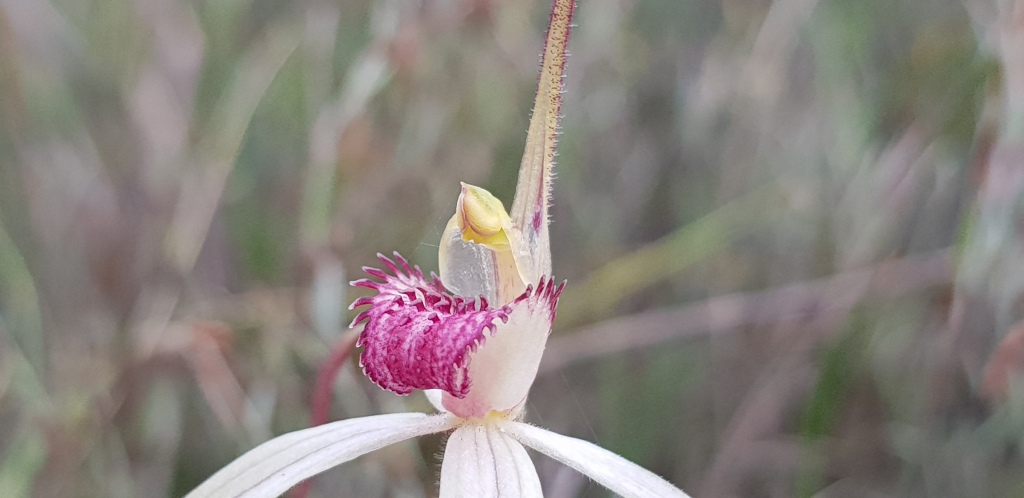Caladenia orientalis
(G.W.Carr) Hopper & A.P.Br.Flowering plant 10–20 cm tall. Leaf 10–15 cm long, 10–15 mm wide. Flowers 1 or 2, strongly scented; perianth segments 7–12 cm long, creamy white to yellowish green with brownish to blackish glandular tips; sepals flattened at base, 2.5–6 mm wide, abruptly tapered to a long tail densely covered in glands and/or glandular hairs; petals shorter than sepals but otherwise similar. Labellum curved forward with apex recurved and lateral lobes erect, lamina ovate, obscurely 3-lobed, 18–22 mm long and 8–12 mm wide (when flattened), cream with reddish margins and calli; margins of lateral lobes fringed with linear calli to 1 mm long, margins of mid-lobe with shorter calli becoming tooth-like near tip; lamina calli in 4 or 6 somewhat crowded rows, extending onto mid-lobe, narrow, foot-shaped, c. 2 mm long at base of lamina, decreasing in size towards apex. Flowers Sep.–Oct.
GipP, WPro, HSF. Endemic to Victoria where found in coastal heathlands and heathy woodlands between Grantville and Yarram, on well-drained sandy soil.
Characterized by its creamy white to yellowish green perianth segments with brownish to blackish glandular tails, but difficult to distinguish morphologically from the western Victorian species C. fragrantissima.
Caladenia orientalis reportedly differs from C. fragrantissima in having larger leaves, a generally shorter flowering stem, larger flowers and a tendency to have more cells in the glandular hairs which cover the tips of perianth segments. However, in herbarium specimens there is no disjunction in the size of flowers, leaves or flowering stem between the two species and the full range of measurements is almost identical for both. Although C. fragrantissima tends to have perianth segment tips covered with 1- or 2-celled hairs (or glands), at least some (e.g. from Nelson) have long hairs identical with those of C. orientalis.
The name Caladenia patersonii R.Br. has been applied to forms of C. orientalis from Wilsons Promontory and immediately adjacent areas but C. patersonii is now regarded as a Tasmanian endemic although morphological differences are slight. The sepal tips of C. patersonii are generally considered to have more densely packed sepaline glands comprising just one or two cells rather than several-celled hairs as in C. orientalis.
 Spinning
Spinning
